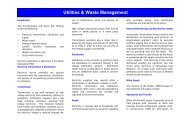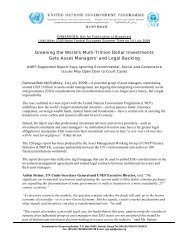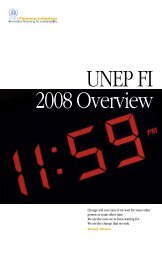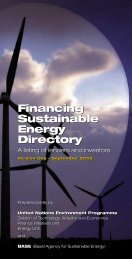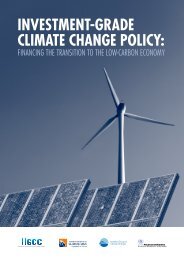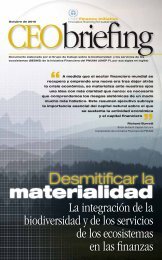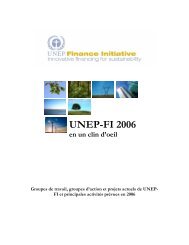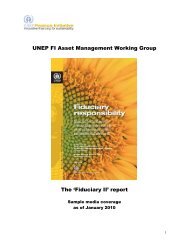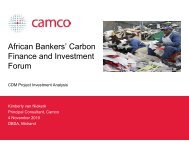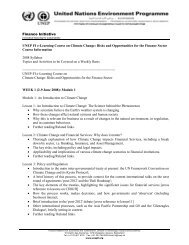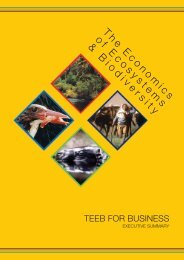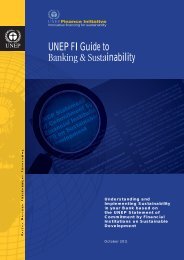Carbon 2009 Emission trading coming home - UNEP Finance Initiative
Carbon 2009 Emission trading coming home - UNEP Finance Initiative
Carbon 2009 Emission trading coming home - UNEP Finance Initiative
You also want an ePaper? Increase the reach of your titles
YUMPU automatically turns print PDFs into web optimized ePapers that Google loves.
<strong>Carbon</strong> <strong>2009</strong><br />
Delivery risk also appears higher<br />
due to the number of delays<br />
most JI projects are currently<br />
facing. Finally, Poznan did not<br />
reduce uncertainty over the role<br />
of JI after 2012.<br />
Russia is still by far the largest<br />
potential source of ERUs, and<br />
the Russian JI framework is the<br />
most critical of the factors above.<br />
The country has a highly complex<br />
system for domestic approval of<br />
JI projects, and Moscow appears<br />
reluctant to approve some project<br />
types, such as those abating<br />
methane leakages. Hence, as<br />
mentioned in our CMA, “Outlook<br />
for <strong>2009</strong>,” Point <strong>Carbon</strong> expects<br />
few if any ERUs to be delivered<br />
from Russian projects in <strong>2009</strong>.<br />
Ukraine more likely<br />
to sell AAUs than<br />
Russia<br />
Survey respondents appear to<br />
share this view (Figure 3.12).<br />
Only five percent of the persons<br />
asked expect delivery of Russian<br />
ERUs this year. Interestingly,<br />
this is very similar to last year’s<br />
response in the sense that just<br />
over one in five expects ERUs<br />
from Russia in the current year<br />
or the year thereafter. The major<br />
difference, of course, is that this<br />
year we are one year closer to<br />
the end of 2012.<br />
How do our respondents see AAU<br />
<strong>trading</strong> in <strong>2009</strong>? The big question<br />
is how much will come to market<br />
from the two countries with the<br />
largest surpluses, Ukraine and<br />
Russia. Figure 3.13 shows that<br />
for Russia, just over half of the<br />
substantive responses expect a<br />
sold AAU volume of more than<br />
zero but no greater than 1 Gt.<br />
One-third of respondents expect<br />
Russia to sell more than 1 Gt in<br />
the 2008-12 period.<br />
In the case of Ukraine, 72 percent<br />
of the substantive responses<br />
are found in the range 0 – 1 Gt,<br />
excluding the zero volume option.<br />
When looking at respondents<br />
in these two countries only, it is<br />
also interesting to note that 12<br />
percent of respondents expect<br />
zero AAU volume from Russia<br />
in the first Kyoto period, while<br />
no respondents in Russia and<br />
Ukraine state that they expect<br />
zero AAU volume from Ukraine.<br />
Consequently, while Russia has<br />
the largest potential volume to<br />
sell, Ukraine appears as the more<br />
reliable country when it comes to<br />
bringing its AAUs to market.<br />
3.6 United States<br />
<strong>Carbon</strong> markets towards 2012<br />
may include a large new player:<br />
the United States. We gauged<br />
respondents’ feelings as to when<br />
the US might establish its own<br />
cap-and-trade program, and what<br />
it might look like.<br />
A compliance market in the US<br />
would not go unnoticed for the<br />
voluntary market. Quite the<br />
opposite, as the prospect of a<br />
future mandatory market already<br />
influences buyers and sellers<br />
strategy on the voluntary market<br />
today.<br />
3.6.1 A US ETS in the offing?<br />
The signals <strong>coming</strong> from the<br />
Obama administration in the first<br />
weeks of his administration are<br />
unequivocal: energy and climate<br />
change are high on the agenda,<br />
and a carbon cap-and-trade<br />
programme is likely to be in place<br />
in 2012.<br />
On February 24, <strong>2009</strong>, President<br />
Obama asked Congress to “send<br />
[him] legislation that places a<br />
market-based cap on carbon<br />
pollution and drives the production<br />
of more renewable energy in<br />
America.” The federal budget for<br />
the year 2010 was released a<br />
couple of days later, and included<br />
revenues from carbon starting in<br />
2012.<br />
Figure 3.12: From Russia with ERUs?<br />
“When will the first emission reduction unit (ERU) be delivered from Russia?”<br />
Note: “Don’t know” excluded from chart. N=2,223 (<strong>2009</strong>); 1,560 substantive<br />
replies.<br />
2008<br />
<strong>2009</strong><br />
2010<br />
2011<br />
2012<br />
Not in the 2008-12<br />
period<br />
Source: Point <strong>Carbon</strong><br />
0% 5% 10% 15% 20% 25%<br />
Share of respondents<br />
<strong>2009</strong><br />
2008<br />
26<br />
All rights reserved © <strong>2009</strong> Point <strong>Carbon</strong>



